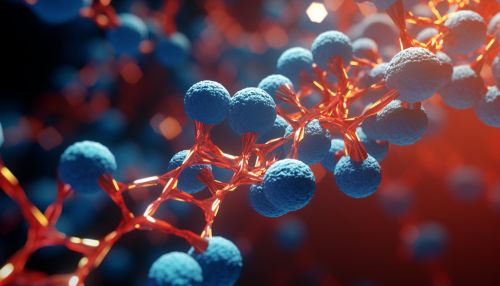Kinase inhibitor
Overview
A Kinase inhibitor is a type of molecule that has the ability to block the activity of kinases. Kinases are enzymes that play a crucial role in the complex cellular processes that sustain life. They are responsible for the transfer of phosphate groups from high-energy, phosphate-donating molecules to specific substrates, a process that is of key importance in signal transduction pathways and regulation of cellular activity. By inhibiting these enzymes, kinase inhibitors can halt the growth and proliferation of cells, including cancer cells.


Classification
Kinase inhibitors can be classified based on their mode of action. There are two main types: reversible and irreversible inhibitors.
Reversible Inhibitors
Reversible inhibitors bind to kinases through non-covalent interactions such as hydrogen bonds, hydrophobic interactions, and ionic bonds. This type of binding is reversible, meaning that the inhibitor can detach from the kinase. The reversible inhibitors can be further classified into three types: competitive, non-competitive and uncompetitive inhibitors.
Irreversible Inhibitors
Irreversible inhibitors covalently bind to their target kinases, resulting in permanent inhibition of the enzyme's activity. These inhibitors are generally more potent than reversible inhibitors, but they also have a higher risk of off-target effects and toxicity.
Mechanism of Action
The mechanism of action of kinase inhibitors involves the binding of the inhibitor to the kinase enzyme, thereby preventing the enzyme from carrying out its function. The specific mechanism of action can vary depending on the type of inhibitor.
Competitive Inhibitors
Competitive inhibitors work by binding to the active site of the enzyme, the location where the substrate would normally bind. This prevents the substrate from binding and thus inhibits the enzyme's activity.
Non-Competitive Inhibitors
Non-competitive inhibitors bind to a site other than the active site of the enzyme. This changes the shape of the enzyme and prevents the substrate from binding effectively.
Uncompetitive Inhibitors
Uncompetitive inhibitors bind to the enzyme-substrate complex, preventing the complex from releasing the products and thus slowing down the reaction.
Therapeutic Use
Kinase inhibitors have found significant use in the field of oncology. Many types of cancer are driven by mutations in kinases, and inhibiting these kinases can halt the growth and proliferation of cancer cells.
For example, imatinib is a kinase inhibitor that is used in the treatment of chronic myeloid leukemia. It works by inhibiting the BCR-ABL kinase, a protein that is overactive in these cancer cells.
Another example is vemurafenib, a kinase inhibitor used in the treatment of metastatic melanoma. It inhibits the BRAF kinase, which is mutated in about half of melanoma cases.
Side Effects
Like all drugs, kinase inhibitors can have side effects. These can range from mild to severe and can include nausea, vomiting, diarrhea, and fatigue. More serious side effects can include liver damage, heart problems, and an increased risk of infections due to a weakened immune system.
Future Directions
Research into kinase inhibitors is ongoing, with many new inhibitors in various stages of development and clinical trials. The hope is that these new inhibitors will be more effective and have fewer side effects than current treatments.
